The last overseas news regarding the new developments of the technology for electric motors concern Texas Instruments.
The multinational has recently presented a driver for brushless DC motor (BLDC) Degree 0, highly integrated, for the drive systems of high-power 48 V motors, such as traction inverters and starter motors /generator of mild hybrid electric vehicles (MHEV). What are its outstanding peculiarities?
DRV3255-Q1 can help designers in reducing the sizes of motor systems by even 30%, providing the highest gate drive current in the sector for better protection and higher output power. Complying with the most severe safety requisites, the new motor driver has been designed according to the development process of TI functional safety certified by TÜV SÜD and shares in reaching the integrity level of ASIL D automotive safety. Further information are available on the site www.ti.com/DRV3255-q1-pr-eu.
The reduction of the board footprint is possible up to 30%: DRV3255-Q1, driver for 48-V three-phase BLDC motor integrates the active high-side and low-side short circuit logic, which eliminates external transistors and the control logic. Through the active short circuit logic integration and the dynamic response to failures, the new motor driver allows designers not only to simplify their designs but also to supply up to 30 kW of motor power, so decreasing the board footprint and the cost in bill of materials for drive systems for 48-V motor.
Driver for 30%-smaller drive systems
A solution to power motor control
Through the completion of the distribution system for MSFS motor starters for automation boards, Eaton makes available for its customers a solution to power motor control and protection circuits enriched with numerous novelties, including a 125 A power supply module, new adapters for modular and box-type switches and a 5 A /24 VDC power supply.
The distribution system has been designed to offer a safe solution for the distribution inside the automation board and it is now equipped with a 125 A power supply module, hence the nominal capacity of the bus bars of the system itself. This allows using MSFS at its highest use current, permitting its full exploitation, while the previous limit was 80 A.
The system is positioned between the base solution, constituted by three-pole bus bar blocks, and the higher-level solution characterized by SASY60i distribution bus bar system, therefore defining a new intermediate standard in terms of cost, versatility and current values for automation systems.
Eaton, in the context of the widening of MSFS system, now proposes new adapters that extend the MSFS use also to utilities not strictly connected with the motor starter. This is possible because they allow connecting to the system both modular FAZ switches up to 63 A and the box-type NZM1 switch up to 125 A.
Meanwhile, in the suitable version (ROSF), also the new hybrid EMS2 starters (Electronic Motor Starter) can be coupled to the MSFS system.
Moreover, among the novelties the system completion provides for, there is also a three-phase 5 A /24 VDC power supply that, in most of automation applications, allows powering 24 VDC auxiliary circuits of the electric equipment of a machine without providing for further power supplies. Finally, the adapters offered until now for «PKZM0/PKE + soft-starter DS7» combinations extend their use possibility also to variable-speed DE1(1) starters up to 1.5 kW.
Custom-tailored materials for metal pretreatment and functional coating
As part of its active global support for the metal coil industry, Henkel is partnering with major coil producers to implement dedicated process solutions for end applications in e-mobility. In addition, the company is also addressing demands for reducing the complexity of downstream manufacturing steps by enabling continuous upstream functional coating processes without compromising the technical properties of the coated material.
Metal coil producers play an essential role in the market of hybrid and fully electrical vehicles, supplying steel and aluminium coils to the manufacturers of batteries, transformers, converters, wound cores, shunt reactors and other key components for e-drive and electrified powertrain systems.
Henkel’s process know-how extends across the entire value chain from the rolling oil for electrical steel to specific pickling inhibitors and cleaners to specialized new functional and conductive thin coatings, such as for covering the aluminium foil used in EV battery systems. Besides providing reliable corrosion protection for painted or unpainted substrates, these products have been custom-tailored to improve the overall performance of e-mobility applications by enhancing insulation and bonding properties, magnetic permeability and electrical conductivity.
Latest product innovations targeted at both upstream and downstream metal pretreatment and functional coating for end products in e-mobility include Bonderite O-TO dedicated product range and Bonderite M-CR 12 series. Bonderite is a registered trademark of Henkel and/or its affiliates in Germany and elsewhere.
The innovation of printed circuit board stator motor
The innovation promised by Infinitum Electric, Texan start-up, concerns the stator. It is implemented in printed circuit board on plastic support instead of with conventional iron. In this solution, the copper circuit is integrated in a single printed circuit board, to reduce the energy dispersions associated to the core, thus proving to be 60% lighter, up to 10% more efficient, more compact and even 25% cheaper than a standard electric motor. Moreover, the electric unit can reduce the torque ripple, minimizing noise while used, can integrate drives in the motor and install all sensors in the printed circuit board stator.
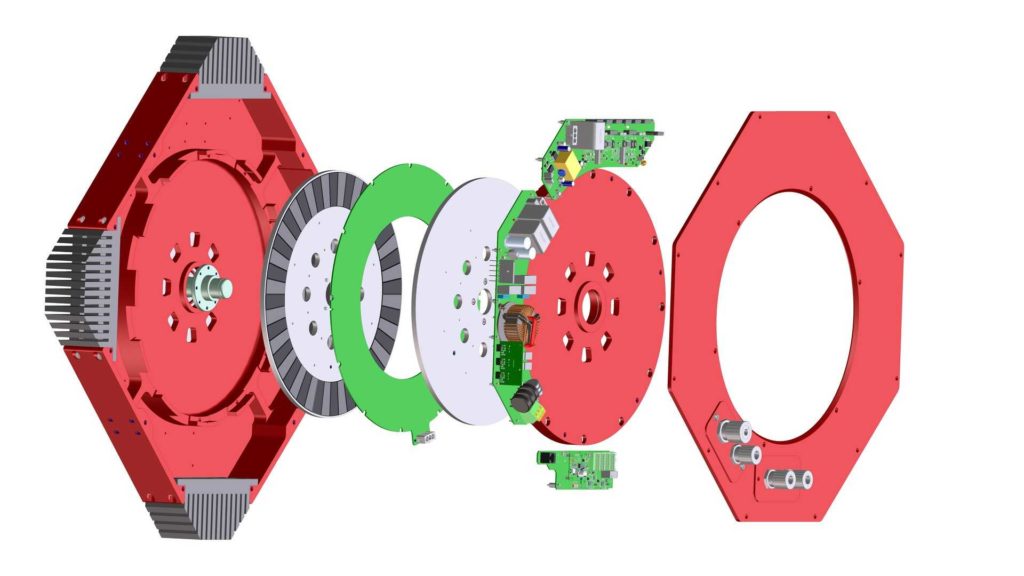 These novelties are expected to make the motor sturdier and more durable because the stator, which contains the entire coil, can boast a thermal expansion coefficient that remains homogeneous in all points. Technologies are protected by 5 patents already registered and other 11 under certification; recently, Infinitum Electric has accomplished the funding of 12.5 million dollars to produce the new motor on a world scale.
These novelties are expected to make the motor sturdier and more durable because the stator, which contains the entire coil, can boast a thermal expansion coefficient that remains homogeneous in all points. Technologies are protected by 5 patents already registered and other 11 under certification; recently, Infinitum Electric has accomplished the funding of 12.5 million dollars to produce the new motor on a world scale.
Dynex Integrated Power Unit (IPU)
Dynex Semiconductor has developed a range of power inverters for automotive applications. With the units being suitable for use with both hybrid and fully electric vehicles driving multiple types of AC motor, Dynex Semiconductor inverters are of compact design with high efficiency and leading power to weight ratio.
The Features of the seminconductors of Dynex are severals. They are optimised for EV and HEV application, the bespoke IGBT power module is designed specifically for HEV/EV application, the double-sided cooling package for IGBT module increasing thermal performance and power density, there is the active gate driver technology with di/dt control. Moreover, there is wide input voltage range up to DC470V, very wide range high system efficiency, advanced and reliable motor control, selection of optimised motor control algorithms for different motor technologies, AUTOSAR compliant software development and emphasis on functional safety according to ISO26262.
DANA spicer electrified e-Axle and e-Gearbox
Two new electric drive train solutions for off-highway vehicles, including the e-Axle and e-Gearbox, are recently introduced in the market by Dana. These technologies enable electrified propulsion by leveraging the company’s portfolio of motors, inverters, and controls.
Aziz Aghili, president of Dana off-highway drive and motion technologies, said: «Vehicle manufacturers in mining, construction and other off-highway markets are efficiently transitioning toward electrification, while retaining a large portion of their products in traditional technologies. Dana has positioned the company to be energy-source agnostic to support our customers across drivetrain configurations, including electrodynamic components that accelerate the adoption of electrification through the introduction of technologies specifically selected to meet the needs of current vehicle architectures».
The Spicer Electrified e-Axle combines Dana’s heavy axle design with a high-efficiency TM4 Sumo HP motor/generator and inverter combination for medium-sized mining trucks, medium-sized load haul dumpers, and large lift trucks.
Supplying 139 kW of continuous power and 193 kW at peak power, the TM4 motor/generator and inverter join together at the center housing of the axle. So to provide the right torque and efficiency within the usual space of an internal-combustion engine and transmission.
Ride Dc brush motors with permanent magnets
The Ride DC electric motors catalog divides into subcategories, identified by the external stator diameter, by the rotor length, in mm and by the presence of the Encoder.
In the subcategories there are different construction options. To support the choice of the best DC electric brushed motor, Ride shows interactive configurable data sheets.
Ride thinks in this way to the customers who need personalized DC electric motors, which can be anyway assembled trough consolidated and automatized processes, which guarantee competitive production costs and the reliability, indispensable in each application.
Between the offered permanent magnet DC motors, for each diameter it is possible to decide for the “standard” or for the “stronger” version: the difference comes from the rotor length. Longer is the rotor higher is the stall torque and the power that the DC brushed motor can reach. Among these products there is M77x40, stall torque from 5,10Nm to 1,27Nm, DC electric motors with brushes.
If requested, they can be equipped with EMC filter, usually made by two inductances and two capacitors.
In the inteactive technical datasheet it is possible to configurate the electric motor by selecting the preferred between the availabel options: motor shaft, filter, characteristic curve.
The interactive characteristic curve allows to select the required performances by selecting power voltage and no-load speed. Eventually it is possible to ask about further personalizations, like a special cables, simply by attaching in the request- form the relative documents.
The M77x40 electric motors are generally applied in linear actuators and in various automatisms.
A compact, clean, solder-free solution
Pioneer in the sector of electric connections, in the late Eighties TE Connectivity invented solutions to replace the old solder process technology for magnet wire connections. The company, multinational worth 14 billion dollars, supplies all-round solutions not only for the electric connection part but also for plastic insulation and assembling.
MAG-MATE connector with Multispring pin is a combination of two key technologies that eliminate the customer’s need to solder. It provides the ability to directly connect magnet wire to a Printed Circuit Board with no solder. Traditionally, the process is to solder magnet wire to a pin, assemble the PCB to the pin, and then solder the PCB to the pin. But now no more, thanks to this product that allows solderless magnet wire termination in the IDC (Insulation Displacement Connection) at the bottom and solderless PCB termination through press-fit Multispring pin on the top.
IDC technology
In the last 15 years, TE Connectivity has developed an optimal solution for the magnet wire termination. It is the family of TE MAG-MATE products for the magnet wire termination, used by many outstanding companies on a world scale in the production of motors and pumps. This product is based on the technology of Insulation Displacement Connection (IDC). For over 40 years, this IDC technology has proven to be an efficacious alternative to the wire stripping and soldering in thousands of applications.
«They are products –Ugo Aime specified – belonging to the “Appliances” business unit, but they can find all-round uses, for instance in the automotive, industrial and medical world, and in all various market applications where a magnet wire termination is demanded».
In IDC system, terminals are provided on a metal band. Manufacturers insert terminals into a plastic cavity by using automatic or semi-automatic insertion equipment. The plastic cavity must use glass-filled material to have mechanical stability and can be molded in the customer’s coil or can be part of a separate component. This molded cavity has two slots on the opposite sides and an inlet chamfer on each slot. The magnet wire coming from the coil is pre-positioned in these two slots manually or through a winding tool. The wire rests on a support or on an “anvil” in the cavity.
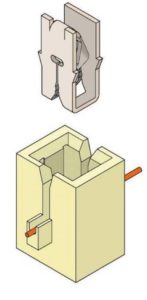 The MAG-MATE terminal has two IDC slots with inlet chambers on the input points of slots. The terminal is positioned on the magnet wire in the plastic cavity and then inserted. Terminals “clean” the insulating film from the wire surface during the insertion. When the terminal has been definitively positioned, the wire is fixed between the two slots for the insulation displacement, to assure a safe and reliable termination. During this process, hermetically sealed contact points are created between the wire and the terminal. The opposite side walls of each slot of the terminal have a residual elastic energy that keeps the pressure constant on the wire, assuring a safe and reliable connection in the long term. Molded plastic slots fix the wire on each side of the metal terminal, assuring an anti-traction action.
The MAG-MATE terminal has two IDC slots with inlet chambers on the input points of slots. The terminal is positioned on the magnet wire in the plastic cavity and then inserted. Terminals “clean” the insulating film from the wire surface during the insertion. When the terminal has been definitively positioned, the wire is fixed between the two slots for the insulation displacement, to assure a safe and reliable termination. During this process, hermetically sealed contact points are created between the wire and the terminal. The opposite side walls of each slot of the terminal have a residual elastic energy that keeps the pressure constant on the wire, assuring a safe and reliable connection in the long term. Molded plastic slots fix the wire on each side of the metal terminal, assuring an anti-traction action.
Aluminum termination
The termination of the aluminum magnet wire use to represent a challenge for the IDC technology. Environmental and mechanical stresses cause in aluminum many more “creep” and “stress relaxation” phenomena than what with copper. Magnet wire manufacturers have succeeded in minimizing “creep” and “stress” phenomena.
The studies carried out by TE indicate that motor manufacturers can shift from copper wires to aluminum wires and use standard insulation displacement terminals to eliminate the pre-stripping and soldering that need specialized manpower.
To assure that the connection process leaves the wire in an optimal region of the connector slot, technicians must indicate the optimal insertion depth for the single application.
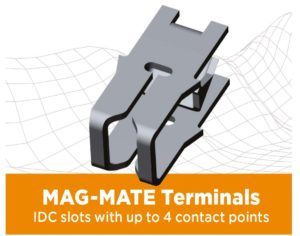
Compact recently patented connection
«Currently, – explained us Ugo Aime, Product Manager Appliance of TE Connectivity – the market trend is focused on developing products that can be used in applications where space is a premium and design-to-cost is extremely important. Reducing components and material, keeping performance, is paramount for success.
According to this strategy, we have developed a new proprietary concept with the support of of P.K. Senthil Kumar, Global Engineering Manager who works in our Bangalore branch, in India.
This concept relates to an assembly for electrical devices that demand a compact and automated solution to transfer power from a power source.
The assembly comprises a TE terminal with IDC that allows solderless magnet wire termination at the bottom and solderless PCB termination through press-fit on the top, with a tab connected with PCB using again press-fit termination».
- Large gas-tight contact zone
- High reliability due to stored energy
- Minimum damage to plated-through holes during application
- Especially suited for multi-layer PCBs
- More economic board manufacturing due to larger hole tolerances compared to the use of a solid pin Application can be made by the end-user
- High-end TE Connectivity application tooling available
- Extraction force equal to Pin/PCB min 40N
MAG-MATE Connector
- Terminates all magnet wire film insulations
- Eliminates need for pre-stripping conductors
- Eliminates need to solder/weld
- Excess magnet wire is automatically trimmed during the termination process
- Simultaneously terminates two magnet wires of the same size in one terminal (for splicing or bi-filing) Available in strip form for semi-automatic or fully automatic insertions
- High speed, fully-automated integrated systems provide uniform terminations reliability at the lowest possible applied cost
- Clean metal-to-metal interface produces stable, gas-tight electrical terminations free of oxides and other contaminants
This solution offers different advantages:
- Cost efficiency: when used with compliant pin variants, a compact solution is obtained that can be automated;
- BOM (Bill of Material) reduction: the connection can be completed with two parts only;
- Reliability: this solution needs minimal intervention and precisely controlled termination eliminates human error;
- Cleanness: it is environment friendly since eliminates need for pre-stripping and pre-solder/weld.
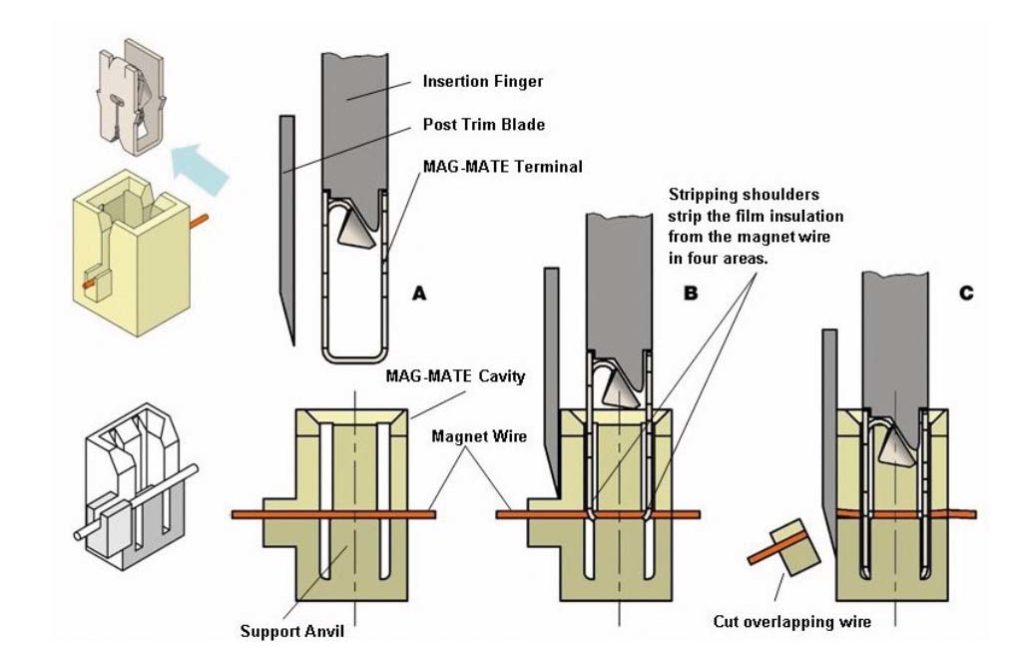
Moreover, «Customers can design their products without using wires and cables; we want to protect this solution of ours on a global scale» – specifies Aime.
Stepper motors: typologies and technical features
Stepper motors play an important role in the manufacturing industry world. Their use prevailigly depends on expectations and applications. If we aim at high precisions, mechanical and electric sturdiness, user friendliness, control and maintenance of the rotor’s position also without power supply, then this motor typology is ideal.
In the present article, we are treating the main typologies of available stepper motors on the market, the essential structural aspects and their operation characteristics in static and dynamic conditions.
The stepper motor is used in small-power drives because it is less efficient than other motors. It allows achieving high positioning precisions and it is suitable for the sectors of robotics, automotive, 2D plotters, 3D printers and several other ambits.
Their name derives from the fact that a well precise angular rotation, precisely called step, is set at each control. They are piloted by opportune electronic switching circuits with open-loop position control. In absence of a specific control, the stepper motor maintains the position reached. In general, we can state that all stepper motors are composed by a stator, where are present the windings made up by copper wire coils, and by a rotor.
In the ambit of the manufacturing industry, stepper motors are classified as follows:
- Permanent magnets (PM);
- Variable reluctance (VR);
- Hybrid (HY).
Permanent magnet stepper motors
The rotor consists of a permanent magnet and shows, on its surface, the same number of poles as those present on the stator, where two phases (or windings) are present.
If we indicate with D the number of pole pairs and with α the pole angle, i.e. the angle taken up by a pair of NS (north-south) poles, we can express the following relation:
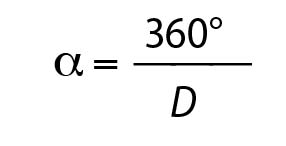
This type of motor can be excited in three ways:
- Single phase, where windings are powered individually and the rotor rotates at each step by 90° and the entire sequence corresponds to a complete revolution of the same;
- Two-phases, where windings are powered simultaneously, with the rotor that aligns between the two pole expansions (operation used when we want to have high torque);
- Half-step. The power supply, in this case, concerns first a phase and then both, successively only the second and so on. At each phase change, the rotation step is by 45°.
In Figure 1, we can see a schematization of the permanent magnet stepper motor.
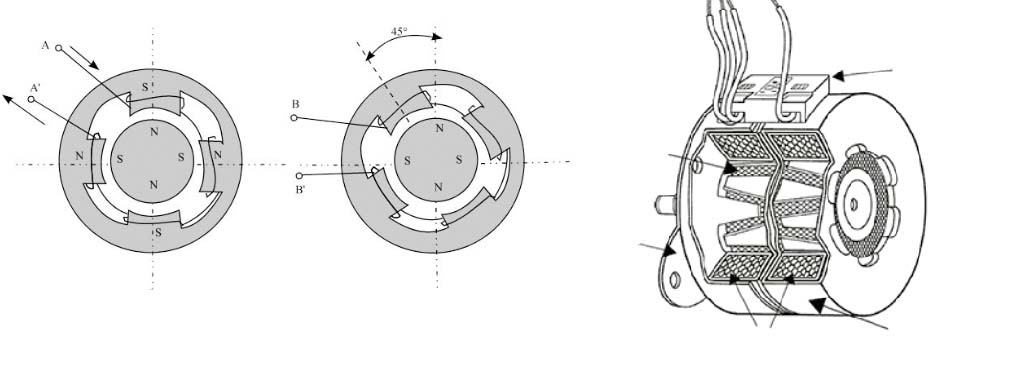
Variable reluctance stepper motors
The operation principle of the variable reluctance stepper motor (Figure 2) can be ascribed to the tendency of mobile parts to be arranged in minimum reluctance conditions. This operation corresponds to attaining inductance and maximum flux. Reluctance, precisely, measures the opposition of a material to the transit of the magnetic flux. The VR motor has a grooved-iron rotor and a stator constituted by a stack of laminations with toothed poles. The rotor has a different number of teeth, or pole expansions, from stator’s. The latter features ns teeth, while the rotor body nr=ns±2. The angle among teeth (ϑr/s) is:
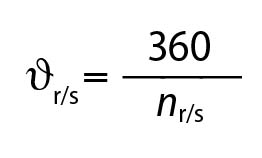
Where s and r stand, respectively, for stator and rotor.
Considering the stator, on each pair of opposite teeth is present a winding that constitutes a phase. The number of phases (F) is given by:
![]()
The minimum number of phases is three (A, B and C). It is not possible to make this motor typology run with two phases only, since the rotation sense would not be determined.
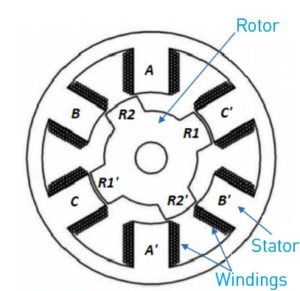
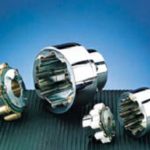
Hybrid stepper motors
The vast majority of stepper motors is hybrid (HY). They group the characteristics of PM and VR motors.
As shown in Figure 3, the rotor is composed by two parts, called cups, magnetized in axial sense (one North and one South), holding a series of teeth alternated to slots. Cups are fitted out of phase, so that the teeth of one correspond to the voids of the other. Indicating with α the angle among the rotor teeth, the phase displacement between the cups is α/2. The stator is similar to the one of VR, with a lamination stack with toothed poles but with just two phases. When the A-phase is excited, the S polarized teeth of the front cup are aligned with the teeth of the N-pole. In the rear cup, with teeth out-of-phase by α/2, the contrary occurs: the N polarized teeth of the rotor are aligned with the teeth of the S-pole of the A-phase. The misalignment between rotor teeth and B-phase ones is worth α/4. When the B-phase is excited, the rotor must rotate by α/4 to be correctly aligned with the poles of the B-phase.
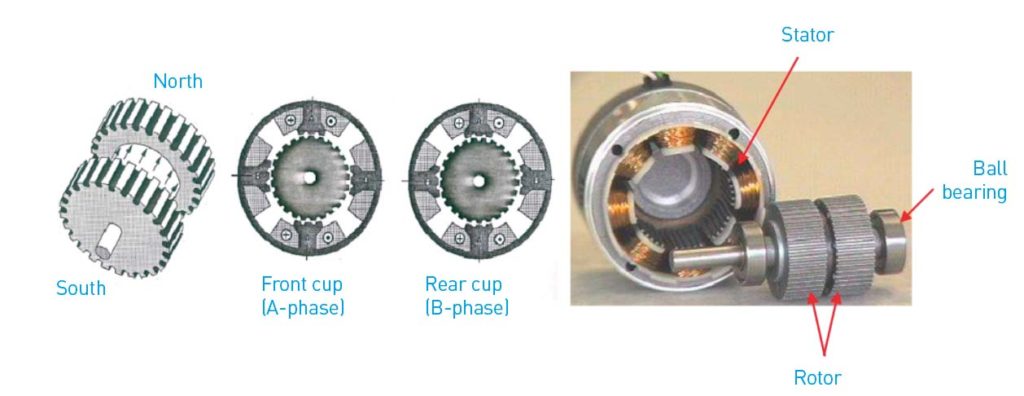
In the successive steps, the front rear cup is always aligned with the N-pole of the excited phase while the rear cup is aligned with the S-pole of the same phase. After Z configurations, the rotor has moved by one tooth, therefore the number of steps per revolution (S) is:
S= nr∙Z
Torque developed in static conditions
Under static conditions, a stepper motor of whatever kind can develop the following torque:
- Holding Torque. Let us consider a stepper motor of any type (PM, VR or HY) and let us power a single phase. The rotor will position itself in a determinate stable position. If, from the outside, we apply a torque and we impose a θ rotation, the magnetic attraction between stator poles and the rotor will oppose the external load, generating an equal opposite torque to the applied torque. Such torque is called holding torque (HT) and it is maximum when the rotation angle of the rotor is equal to α/4, where α is the pole angle, i.e. the angle taken up by a pair of poles. In such condition, rotor’s poles are in intermediate position with regard to the ones of the stator and are subjected to both the attraction of the opposite pole and to the repulsion of the homonymous pole. If we go on increasing the rotation, the stall torque starts diminishing, to the extent of being annulled by an angle equal to α/2. The homonymous poles of rotor and stator are aligned and repulsive forces have null tangential component and create no torque. Such condition corresponds to a situation of unstable balance as the torque is null but a small rotation (positive or negative) is sufficient to make the rotor return to the successive or previous step. The reaction torque, in fact, changes its sign and tends to make the rotor return to the initial position or to the position corresponding to the successive step. The situation illustrated in Figure 4 refers to a PM motor.
- Detent Torque. When a stepper motor is not powered, we would expect a null torque at the rotor. Actually, in PM or HY motors, even in absence of power to the stator phases, a Detent Torque DT appears. The entity of such torque ranges from 5% to 20% of the Holding Torque. In case the motor must maintain the position in absence of power supply, we try to rise the detent torque as much as possible with a suitable profile of teeth. If, instead, such torque is bothering, we will try to minimize it. It is worth noticing that the average value of the detent torque is not null, owing to the friction on bushes.
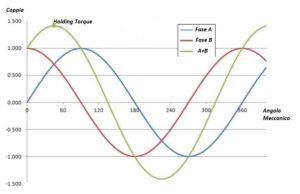
Torque developed in dynamic conditions
Operating the motor with some piloting circuits, it is possible to assess the operation of stepper motors in dynamic conditions. In technical literature, we can distinguish two operation typologies (Figure 5):
- Operation in pull-out (pull-out torque). The maximum torque the motor can develop during the rotation is called pull-out torque and it is equal to about 90% of the holding torque. In practice, we suggest choosing the size of the motor to work with torque corresponding to about 50% of the Holding Torque. At the so-called pull-out speed, the relative torque annuls. Catalogues, then, provide graphs of the Pull-out torque according to speed.
- Operation in pull-in (pull-in torque). To allow the motor to develop the Pull-out torque, it is necessary that the drive takes it to the wished speed, through opportune acceleration ramps. The frequency of impulses to single phases must gradually increase up to the desired frequency, if we want to develop the pull-out torque. However, drives are not always so sophisticated: in many applications, the still motor is immediately powered at the maximum frequency, without using gradual acceleration ramps. This is the operation in pull-in. If the speed is low, the motor starts in pull-in without difficulty but, at higher speeds than the so-called pull-in speed, the thing is no longer possible and the motor does not start even without load. In catalogues, manufacturers provide the torque curve in pull-in, too.
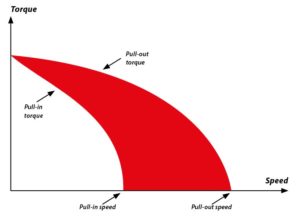
Conclusions
Stepper motors play an important role in the manufacturing industry world. Their use prevailingly depends on expectations and applications. If we aim at high precisions, mechanical and electric sturdiness, user friendliness, control and maintenance of the rotor’s position also without power supply, then this motor typology is ideal. However, we should take some limits into account, like the impossibility of having high speeds, the heat production and, especially, the need of providing for suitable piloting systems.
Flexible heating at the service of electric mobility
Alper produces polyester flexible heaters, electric and electronic circuits for the most different applications in several sectors. Among them, also the challenging automotive industry, to be meant in its widest scope, addressed by the company with a broad range of customized solutions where stand out those purposely studied for battery packs.
The mobility world is decisively looking at an electric-speaking future. In this context – no matter whether hybrid vehicles, as combination of endothermic and electric motors, or fully electric are at stake – battery packs undoubtedly play a protagonist role. An ambitious challenge accepted also by Alper, flexible heating specialist able to design and manufacture ultra-flat polyester resistances precisely used to make battery packs reliable and performing in time.
«It is known – the owner and general manager, Guido Alessi, explains – that the most diffused and used typologies of Lithium batteries for these applications, outside determinate temperature ranges, cannot always maintain optimal efficiencies.

In temperature conditions below zero, for instance, they can feature some criticalities: to slow down the times needed for their recharge, to consume more energy, to supply less powerful pickups, and therefore to provide minor efficiency. Not fortuitously, for a long time now all manufacturers have attentively considered the so-called Thermal Management, fundamental issue to maintain battery packs at optimal temperatures to provide the best operational conditions».
Technical divisions, research and development departments of battery manufacturers, or directly automotive companies and electric vehicle producers, try then to solve such problems by implementing some devices.
«Concerning the solution of criticalities caused by cold and too low temperatures –Alessi adds – it is common practice to provide for the integration of adequate resistances directly among the cells of battery packs, or as external barrier that heats the chassis».
Another interesting solution allows instead exploiting the already existing liquid cooling system, suitable for regulating the functional heating of the battery at steady-state.
«In this case –Alessi highlights – it is possible to exploit the plates of the liquid cooling system, applying suitable heating elements and a simple 3-way valve. This allows by-passing the radiator entrusted with the standard, to exploit this mini-circuit that becomes the heating source for batteries».
Flexible polyester heating elements for electric batteries
More in detail, Alper ultra-flat resistances allow minimizing the necessary thickness of the heating element (from a minimum of 0.2 mm).
Usable in several application fields, like the broad diversified ambit of e-mobility, such resistances are produced by silk-screen printing, with an additive manufacturing technology, initially depositing silver tracks, for the electric current transport, and afterwards a layer of conductive and heating pastes.
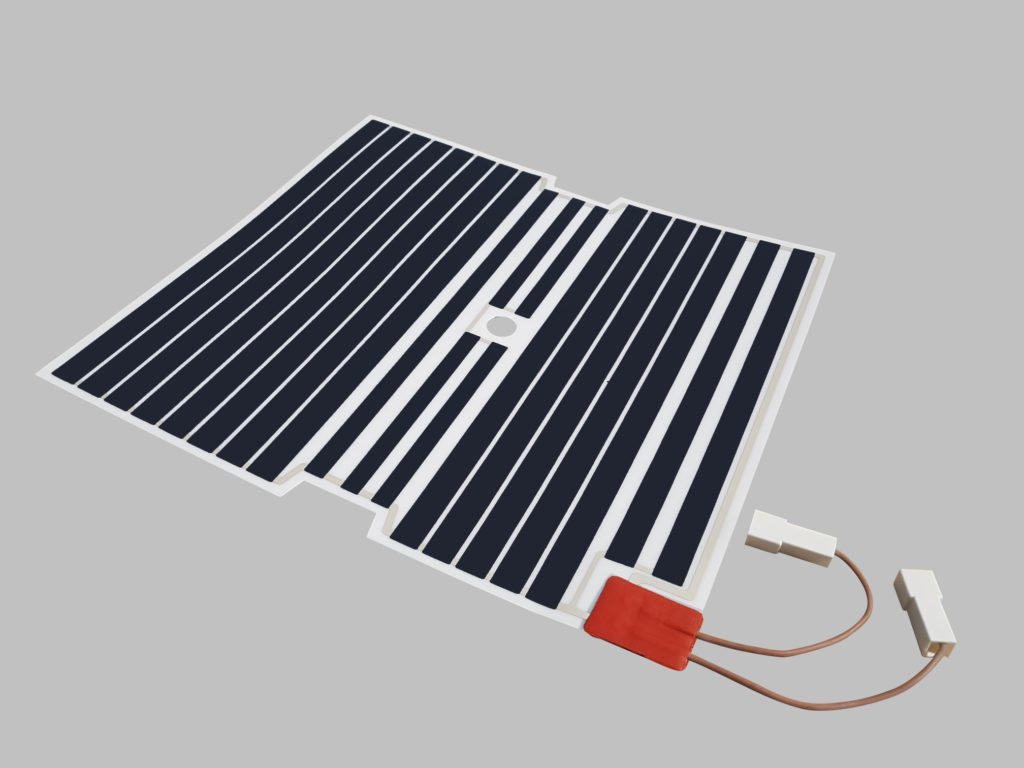
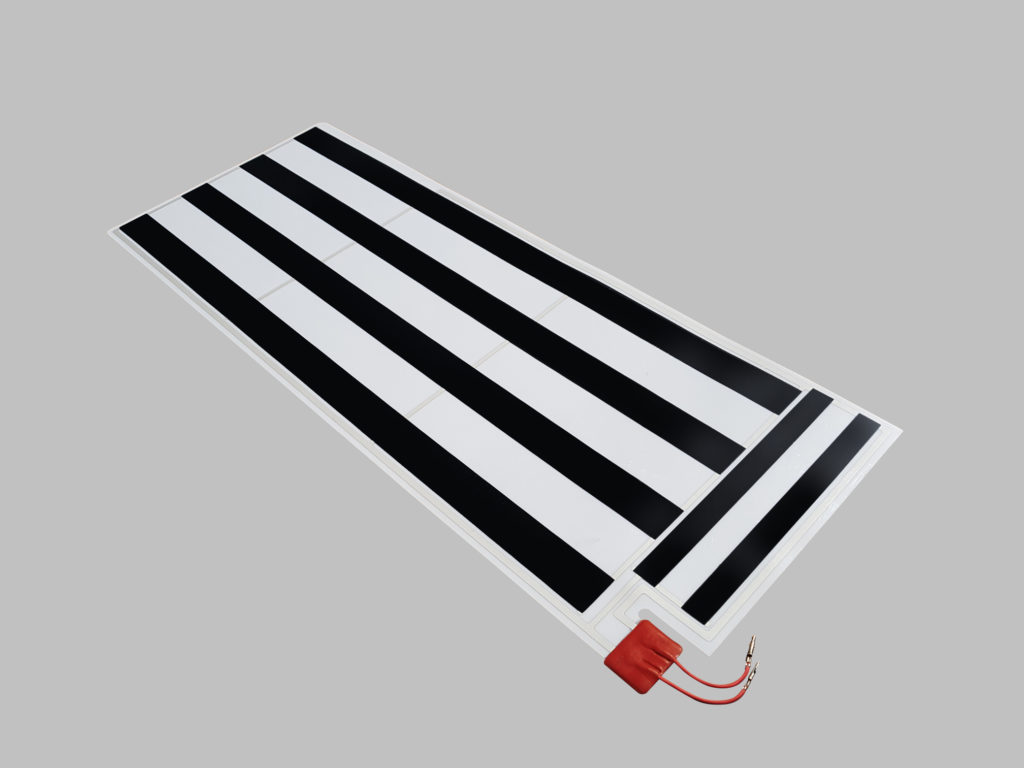
Similar to etched-foils, but much more reliable in terms of flexibility, they assure the highest efficiency levels at the service of low-temperature heat production. The constant research of new heating formulations has allowed the company to make the production capacity and the development of new design products, on customer’s precise specification, very versatile. The technology, unique of its kind, permits to reduce the costs of implementation and of eventual small modifications of the demanded powers (with a significant range of +/-20%) just modifying the composition of the conductive paste (unfeasible thing with etched-foil technology). All that allows implementing electric resistances with very high ohmic value, hardly feasible thing with other alternative technologies on films or with heating cables.
«Peculiarities and features –Alessi specifies – from which can benefit the battery packs designed for cars, trains, bicycles, motorcycles and any other electric vehicle, also used in industrial ambit such as forklifts or in shipbuilding. As many are the operational benefits for the same battery packs deriving from the use of ultra-flat flexible heating elements we design and manufacture: extension of the service life of the battery itself; increment of the good operation also at low temperature; faster recharge times, high temperature uniformity».
The added-value of the additive manufacturing technology
The use of highly thermo-stabilized polyester supports, properly treated for the adhesion of conductive silver and carbon pastes, confers high mechanical resistance and equal reliability in time to Alper heating elements (protected by dielectric films that allow passing the electric rigidity tests exceeding 3,750 V).
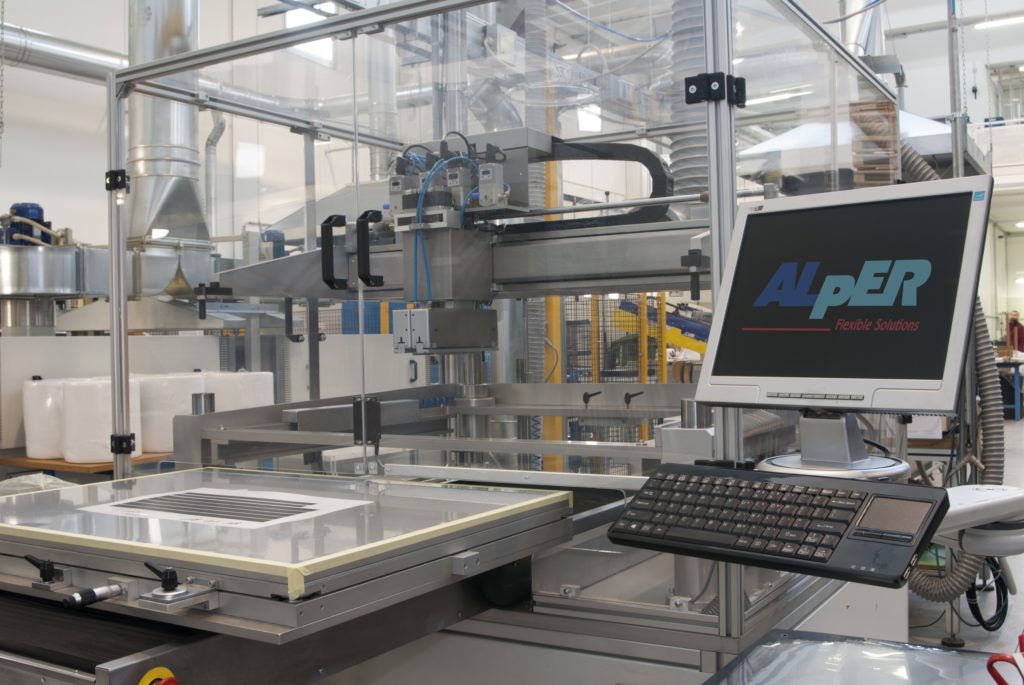
«Conductive pastes – specifies Alessi – as well as the conductive and resistive part that generates heat, are in-house studied, formulated and implemented, upon single specification and according to the application. An additive manufacturing technology, instead of subtractive, which then does not use chemical processes. In other words, our processes do not produce noxious industrial wastes, and even less polluting or toxic wastes to be disposed, with an undeniable environmental and ecologic benefit».
The heating element is printed on a very thin and flexible support and therefore it can be positioned in very narrow spaces, adapting it to curve surfaces, too. Various shapes of the element are possible, as it can have also holes or slots for applications needing them.
Worth highlighting that Alper carbon heating elements are made with very ductile conductive pastes, then they always assure great reliability even subjecting the heating circuit to constant movements and bending. Moreover, according to their composition, they allow silk-screen printing resistances that are not constant when the temperature changes but instead increase hand in hand with its rise.
«In practice –Alessi explains– this results in a decrease of the absorbed power proportionally to the high temperature level reached. This feature is very important from many points of view, safety included: resistances of this kind are in fact prearranged to reach the correct thermal balance with the environment».
On demand, Alper can supply a broad range of accessories, like for instance NTC probes, thermocouples, pt100, pt1000, fixed and adjustable thermostats and pockets for probe housing.
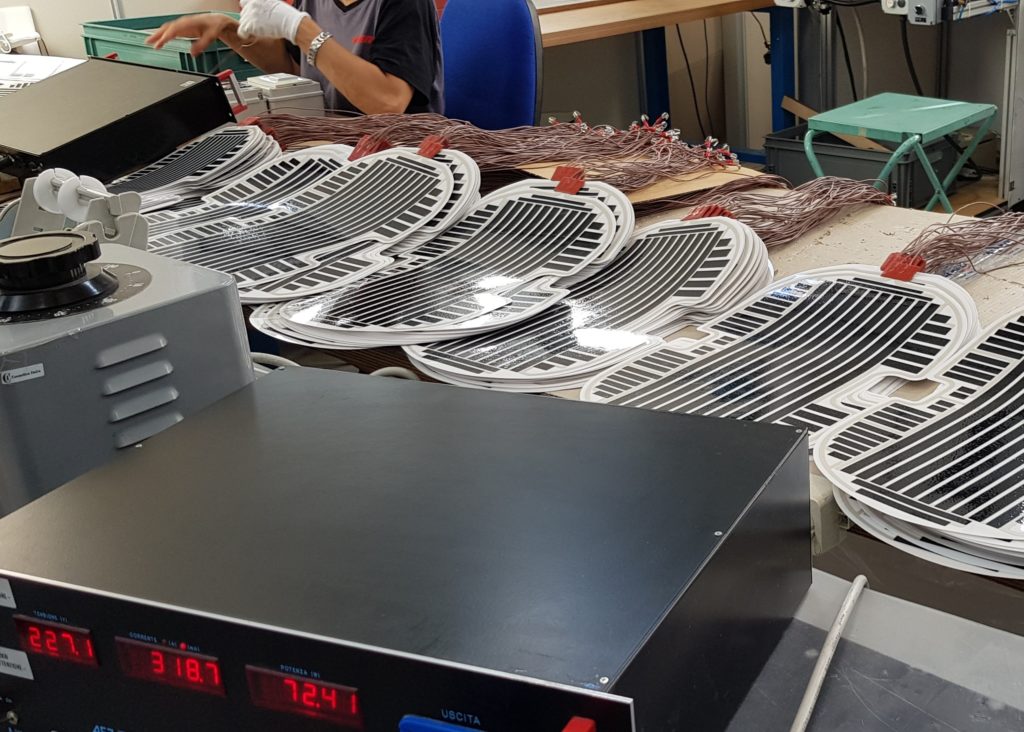
«Still for the automotive industry –Alessi adds– we produce also silk-screen printed antennas for the reception of digital radio stations, i.e. DAB, generally integrated in spoilers, in bumpers and wheel arcs of modern cars. Moreover, our ultra-flat carbon resistances are suitable for heating rear-view mirrors, some inner parts of cars, like seats, mats, roof as radiant heating of the car interior, arm rests and so on».
Total 100% quality
ISO 9001 and ISO 45001 certified, since its establishment conceived and organized as structure oriented to the process efficiency and the product quality, Alper has always paid great attention to its development cycle, granted by a skilled team. A group today consisting of twenty workers whose activity exploits advanced managerial systems and software, from design to production, from testing to logistics.
“The manufacturing process – ends Alessi – is constantly managed, coordinated and monitored in each phase, assuring high quality. The operational course provides for a total 100% control and not for a sampling test codification”.
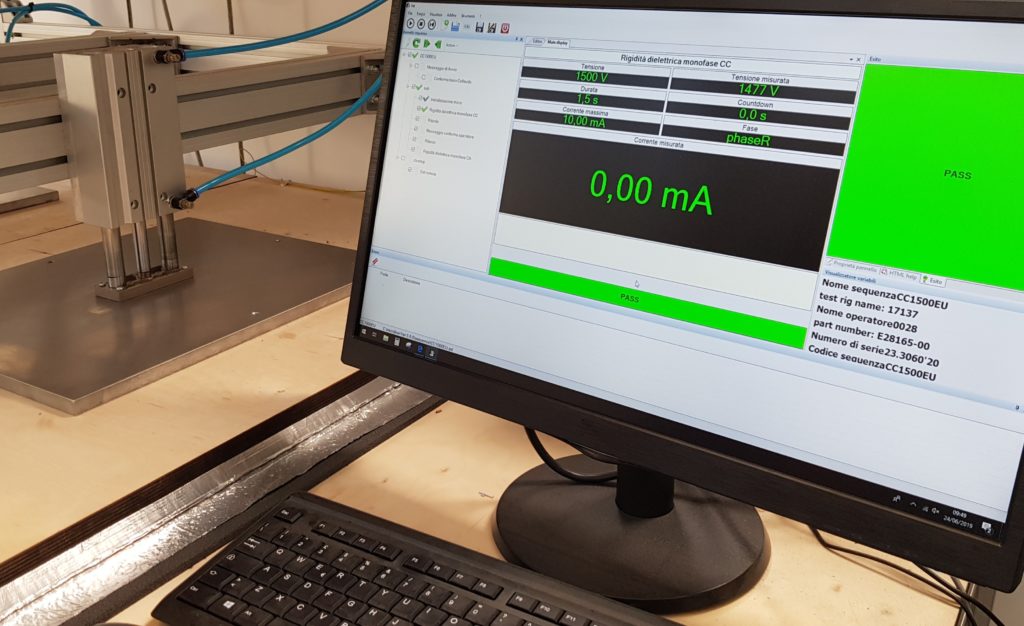
Uncompromised total quality, then, combined with certain production times. All that confers the company great efficiency and precision in deliveries, appreciated by direct and indirect customers, spread worldwide. Concerning this, it is worth underlining that Alper, with the precise target of providing higher and higher level service, for a couple of years now has been able to certify its products also as required by UL regulations for the American market.
The company in brief
Established in 1992 as Research & Development Centre of Carbon conductive pastes with PTC effect, Alper developed, first in the world, a range of polyester heating elements with high power density, which has allowed its customers to be the first entering the USA market with innovative products. Building on the gained know-how, astride 2000s the company starts diversifying its product range. A winning choice that determines a constant growth up to being today, in Italy, a forefront manufacturing reality that produces flexible heating elements, made of polyester and other materials, for the most different applications and markets, with over half million units produced yearly.

A company that still today, in Italy, is unique of its kind, with a proposal of ultra-flat heating elements that allows satisfying the most different technological, productive and qualitative requirements. In addition to the household appliance industry, among the main supplied sectors stand out the general industry, Ho.Re.Ca, building and the rising automotive, for a turnover amounting to about 2.5 million Euros, half of which directly addressed abroad (from Germany to Spain, from England to France), considering that also 80% of the remaining part goes beyond the borders.












